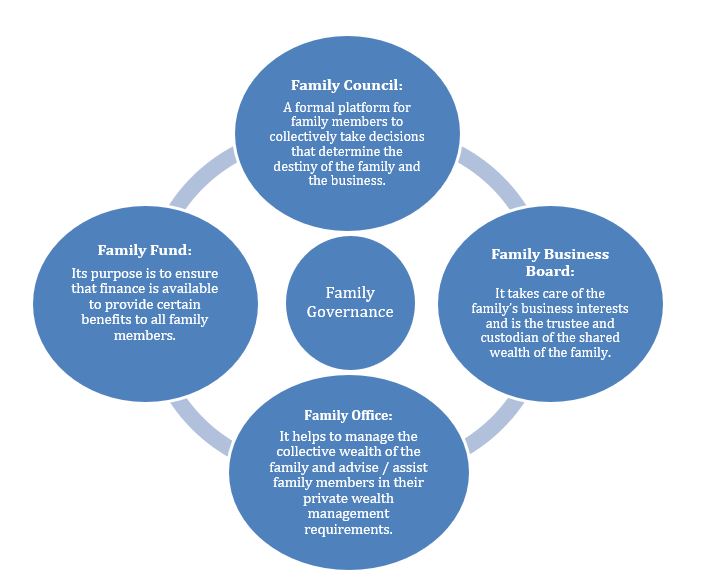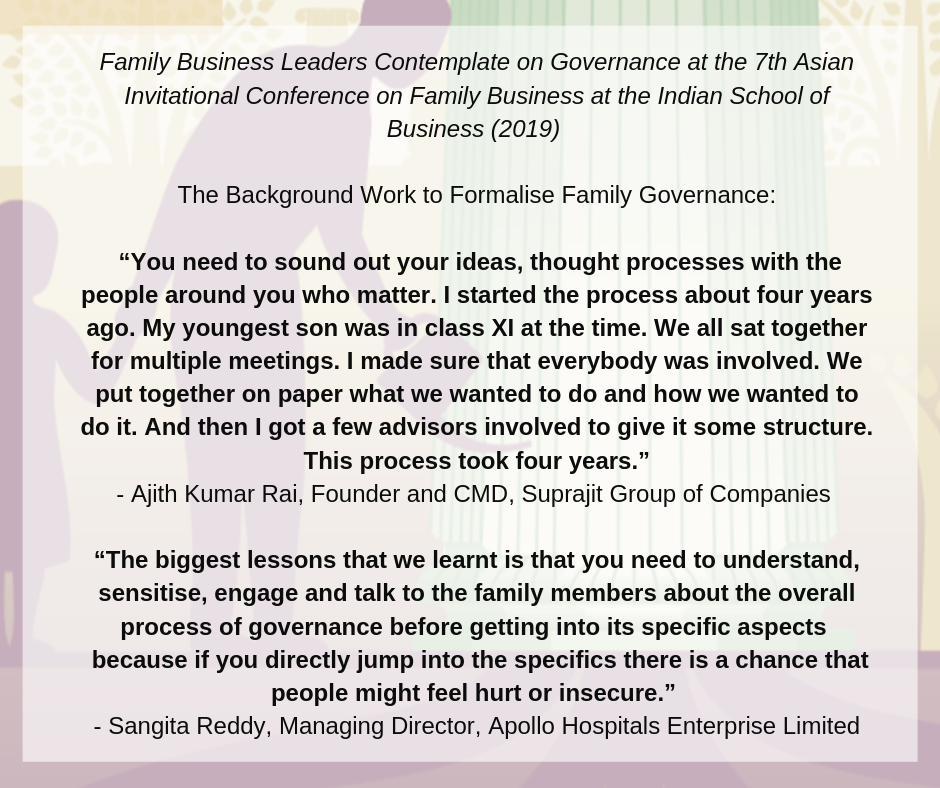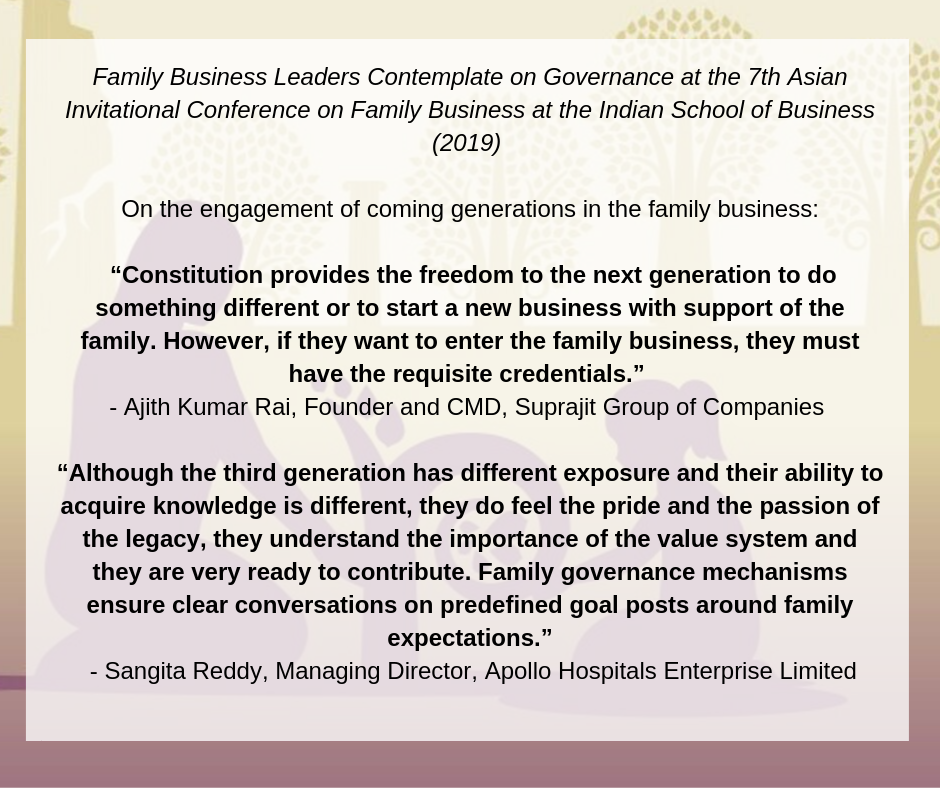More than 90% of the businesses in India are family-owned.1 A large number of them do not remain together beyond three generations and many do not survive the impact of family disruptions on the business.2 Thanks to increasing academic interest in the subject and pioneering efforts by industry bodies, awareness about family governance in India has increased substantially. In multiple cases, splits in the family have resulted in loss of synergy, destruction of value, reputation and relationships.
More than 90% of the businesses in India are family-owned. A large number of them do not remain together beyond three generations and many do not survive the impact of family disruptions on the business.
The proponents of Family Business Governance believe that a lot of financial and economic value and happiness can be unleashed in family-owned enterprises when both the family and the business are governed well.
The Commonly Followed Path
Members of the family may not have equal capabilities; they may not contribute equally to the business and providing equal opportunities to all of them may be difficult. There may also be differences in lifestyle and mindset among family members, even though they live and work together. Failing to handle such differences or ignoring them can cause them to escalate into disputes and lead to separation. Misunderstandings and miscommunication can generate mistrust and weaken the family ties. The tangible effects of this mistrust are the destruction of wealth and disrepute to the family and business.
Misunderstandings and miscommunication can generate mistrust and weaken the family ties. The tangible effects of this mistrust are the destruction of wealth and disrepute to the family and business.
This dynamic is exemplified in the feud between the Singh brothers of the Ranbaxy Group. In just over a decade, a leading business family lost their reputation, their companies, in addition to a great deal of money. According to the Economic Times, the Singh brothers’ relationship came under pressure after one accused the other of financial wrong-doing. Shivinder made scathing allegations of financial misconduct in his petition filed with the National Company Law Tribunal against his elder brother Malvinder. Then Malvinder accused Shivinder of physical assault.3
Or consider the father-son dispute in the Raymond group. According to the information gathered by the Mint, Madhupati Singhania, elder son of Vijaypat Singhania stated in the affidavit filed with the court that the relation between him and his father was strained and that he left the country because of irreparable differences. Two events played a major role here. One, the way in which Vijaypat treated his wife (and Madhupati’s mother) Asha Devi Singhania and two, his decision to elevate his younger son Gautam to the position of Managing Director of Raymond. When Vijaypat gifted 37.17% stake in Raymond to Gautam, Madhupati’s children claimed their right to the Raymond brand, ancestral properties, real estate and other movable and immovable assets of the group.4
Underlining the lessons of the Ranbaxy case, Professor Kavil Ramachandran, Executive Director, Thomas Schmidheiny Centre for Family Enterprise at the Indian School of Business has argued that in general, the best way to prevent such things from happening is to ensure that the head of the family behaves like a real steward who takes care of the interests of all members and is fair to all of them, whether he likes them or not.4
Otherwise, matters usually go up to the court like in the cases of Ranbaxy and Raymond.
How Families Can Avoid Escalation
First, family members must understand that family and business are two different entities with different sets of emotional, philosophical and strategic requirements. A family business has three dimensions — ownership, management and the family.5 Family and business are intertwined. The roles of owner and manager may be carried out by the same set of people, all of whom may be family members.
There can be multiple instances where these dimensions may clash. While the management may want the reinvestment of profits in business, as owners, the same set of people may want distribution of the income. Similarly, the family may want higher responsibilities and less accountability for family members working in the business. On the other hand, the management might advocate assignment of responsibilities commensurate with the abilities of family members and consistent with those of non-family executives. It might also demand the same, if not more accountability from family members. The multiple overlapping roles for the various internal stakeholders make management of family businesses quite challenging.
Family businesses must, therefore, establish separate governance mechanisms for effective functioning of the family and the business. While governance of the business is taken care of to some extent by regulatory requirements and external stakeholders, family governance is a voluntary activity, albeit an important one. A family must put in place mechanisms to avoid disputes and not just survive but thrive in the market. Creating systems and processes for the family as soon as possible helps the long-term sustainability of the business and the family.
Creating systems and processes for the family as soon as possible helps the long-term sustainability of the business and the family.
Family governance involves shifting the focus from individuals to institution building. It also creates alignment among different family members. Alignment in the context of family business means having healthy respect for each family member, their views, roles and contributions to the family and the business. There should be agreement on ways and means to ensure accountability amongst all family members. The journey towards family business governance can be initiated at any time. There is no right or wrong time to do it. The earlier, the better, preferably when the founder is in control.
The family business institution is independent of the individual members and has some core values and purpose that bind it together. By defining the roles and responsibilities of the family members in terms of their capabilities and interests in the family and business, any scope of ambiguity can be removed. Platforms for communication can be created to ensure the happiness of individual members, family alignment, business growth and accountability at all levels. Family governance mechanisms can encourage family members to be adaptable to changes in the market and the family.
The Constitution: A Tool for Family Governance
Every family business already has in place some unwritten values that bind them together. The intention of a formal governance mechanism is to address the areas which lie beyond these values. Such a mechanism brings clarity and focus and helps bridge possible gaps in understanding and alignment in the areas covered by the formal governance mechanism.
Family governance can be put in place either by the family itself or with the help of an expert. It involves discovering the family philosophy, developing policies, detailing processes and setting up structures like the Family Council, Family Business Board and Family Office, based on the needs and context of the family. Awareness about family governance has now started increasing. In the past decade, an ecosystem has emerged to make it possible for family businesses to embrace governance mechanisms, which have enriched them immensely.
The Constitution is the framework of governance, the formal document, which facilitates perpetuation and growth of the family and business over decades and across multiple generations. It enumerates the purpose, core values and goals of the family and the business. It lists down the family policies on privileges and responsibilities of family members, conflicts of interest, transfer of wealth from one generation to another, employment, compensation, succession, etc. The Constitution also lays down the functions of bodies like the Family Council, Family Business Board or Owners’ Council, Family Office and Family Fund.
The Constitution is the framework of governance, the formal document, which facilitates perpetuation and growth of the family and business over decades and across multiple generations.
Each of the bodies performs distinct roles. For example, the Family Council takes decisions on family matters while the Family Business Board decides on matters pertaining to the business. These bodies meet periodically and deliberate on the important issues at hand. Everyone feels heard and understood in these meetings and there is room for new ideas to emerge. This, in turn maintains openness and cohesion within the family.
Drafting the Family Business Constitution
The process of drafting a Family Business Constitution is as important as the document itself. It necessitates the presence of an internal driver or champion who passionately leads the process. Often the first step for the leader involves convincing the family members about the need for formulating the Constitution and enlisting their support in this venture. Before beginning the process of documentation, it is essential to address worries, insecurities, fears, confusions and resentments that any member of the family might have.
Before beginning the process of documentation, it is essential to address worries, insecurities, fears, confusions and resentments that any member of the family might have.
Few families have developed Constitutions on their own by reading books, attending conferences, doing secondary research and meeting families that have gone through a similar process. However, the percentage of families going for external help is going up as generally there is resistance from other family members.
- Unburdening of emotional baggage in relationships: Difference in opinions among family members can often cause stress and conflict in relationships rather than generating better perspectives and facilitating effective decision making. Successful Family Governance mechanisms facilitate identification, communication and resolution of suppressed emotions.
- During the Constitution building process, family members identify important issues at the family, management and ownerships levels and arrive at a decision-making process for each. The Family Business Constitution empowers the leader to have the ultimate decision-making power on certain matters, while others are to be settled through a vote of majority. In some cases, the consensus of all the members is necessary to take the decision while in others a special or simple majority vote serves the purpose.
- Alongside the Constitution development process, large family businesses often decide to reorganise their ownership structure. This is done to bring in better discipline among the members and to prevent any individual from selling his or her stake without the family’s consent. It also ensures compliance of the family members with the family ownership agreements which lists out the terms of exits, transfer of ownership, board memberships etc. in a legally binding Shareholders’ Agreement.
- The process of putting together the Constitution also ensures transparency in ownership of wealth outside business (including common assets like family homes, guest houses etc.) and their effective management.
- Creating effective channels of communication ensures the wellbeing of both the family and the business. To successfully run a family business, the top management must have clear and spontaneous channels of communication with the rest of the team. The health of the business depends on how well the top team communicates. If everyone can express themselves without worrying about what the other person will think, then the business is heading in a positive direction.
Over the last 10 years, reputed industrial houses like the GMR, Apollo, Bharatrams (SRF), Shrirams (DCM Shriram), Dainik Bhaskar and Dalmia Bharat Group have created their Family Constitutions. They have also liberally and extensively shared their experience and become proponents of the idea. All of them took external support from ‘family business’ experts in developing their Family Constitutions.
While these are large and known business houses, there are many small and medium sized family businesses (with turnover of Rs 100 crores to Rs 1,500 crores like Sudarshan Chemicals, Paragon, Synthite Industries, Kanohar Electricals, Creative Travel etc.) which have also drafted their Family Constitutions with the help of family business experts. In majority of the cases, Constitution creation was followed by succession planning or transition of leadership, professionalisation of the business, creation of empowered and effective Boards. These were accompanied by conscious efforts at grooming and training the coming generations.
Drafting the Constitution is only the first move towards putting in place an effective family business governance mechanism. Its implementation constitutes the next big step.
Challenges in Constitution Building and the Way Forward
- The immense hunger to earn and dreams of a prosperous future drive the founders of family businesses, many of whom come from a humble background. Conversely, the next generation is born in wealth and have multiple career and lifestyle choices available to them. With these privileges and liberties, the challenge is igniting passion in the next generations for the family business.
Sangita Reddy, Managing Director, Apollo Hospitals Enterprise Limited belongs to the second generation of her family business. She recounts her childhood memories of seeing her father wake up at 3 am to attend a cardiac patient, save a life, come home, have a quick shower and go back to work. If people asked him about the source of his energy, he would say doing something for people drives him. This fuelled the passion within her sister and herself to contribute to the family business and society.
- The second challenge is balancing the aspirations and capabilities of the next generation while creating family governance mechanisms.
- Another challenge could be the reward system for family members. Not all members contribute equally to the business and not all of them may be involved in the business. Separating the dividend income accruing from ownership from the salary they may derive from working in the business is one way forward.
- Managing emotions is another big challenge despite putting objective systems in place. It is important to invest time and effort to understand the underlying unmet needs of individual family members and to empower and support the person to meet them.
Implementation and living by the Constitution can be challenging. Continuous reinforcement and evolution of the Constitution are required. The Constitution must evolve with time and based on needs. Conducting periodical meetings, rituals with the entire family coming together, celebrating the Founder’s Day and having meals together provide opportunities for formal and informal communication among the family members. Positive communication plays an important role in ensuring proper implementation of the Constitution.
Conclusion
Going through the process of drafting the Family Constitution is an eye-opener in itself. The Constitution shifts the focus to the institution (family and business) and puts it before personal interests. The formation of governance bodies such as a Family Business Board is a positive outcome of this process. A capable and committed Board can bring together unbiased and divergent perspectives in dealing with the ongoing challenges in business. It also builds alignment among different stakeholders in the business.
The Constitution shifts the focus to the institution (family and business) and puts it before personal interests.
Implementation of the Constitution is the most daunting task before the family. Agreeing to rules on paper does not lead to mindset and behaviour change of family members. These require individual effort and persistence over a few months. A strong internal champion smoothens the process of implementation. Giving space to individuals, respecting their humanity and constant learning, unlearning and relearning are the essence of this process.
Finally, as Puneet Dalmia of the Dalmia Bharat Group puts it, “generosity, patience and empathy in the drivers of change and leaders who initiate the journey of family governance are critical to the success of the initiative”.6












